Influence of Solvents and Adsorption of Organic Molecules on the Properties of CVD Synthesized 2D MoS2
Abstract
1. Introduction
2. Materials and Methods
2.1. 2D Material and Organic Molecule Synthesis
2.2. Sample Preparation and Measurement
3. Results and Discussion
3.1. Influence of Solvents on MoS
3.1.1. Water and Acetone as Solvents for Droplet Modification: Unsuitable Outcomes
3.1.2. Methanol and Ethanol as Solvents for Droplet Modification: Challenges and Limitations
3.1.3. Isopropanol as a Solvent for Droplet Modification: Advantages and Success
3.2. Modification of MoS Samples Using L63MS Molecule
4. Conclusions
Author Contributions
Funding
Data Availability Statement
Acknowledgments
Conflicts of Interest
Abbreviations
| 2D | Two-dimensional |
| L63MS | 6-(4,5-Dihydro-1H-imidazol-3-ium-2-yl)-2-(naphthalene-2-yl)benzothiazole methanesulfonate |
| AFM | Atomic Force Microscopy |
| BP | Black Phosphorus |
| CVD | Chemical Vapor Deposition |
| hBN | Hexagonal Boron Nitride |
| MoS | Molybdenum Disulfide |
| PL | Photoluminescence |
| SiO | Silicon Dioxide |
| TMDC | Transition Metal Dichalcogenide |
| vdW | Van der Waals |
References
- Novoselov, K.S.; Geim, A.K.; Morozov, S.V.; Jiang, D.; Zhang, Y.; Dubonos, S.V.; Grigorieva, I.V.; Firsov, A.A. Electric Field Effect in Atomically Thin Carbon Films. Science 2004, 306, 666–669. [Google Scholar] [CrossRef] [PubMed]
- Wang, S.; Rong, Y.; Fan, Y.; Pacios, M.; Bhaskaran, H.; He, K.; Warner, J.H. Shape Evolution of Monolayer MoS2 Crystals Grown by Chemical Vapor Deposition. Chem. Mater. 2014, 26, 6371–6379. [Google Scholar] [CrossRef]
- Alam, S.; Chowdhury, M.; Shahid, A.; Alam, R.; Rahim, A. Synthesis of emerging two-dimensional (2D) materials—Advances, challenges and prospects. FlatChem 2021, 30, 100305. [Google Scholar] [CrossRef]
- Shanmugam, V.; Mensah, R.; Babu, K.; Gawusu, S.; Chanda, A.; Tu, Y.; Neisiany, R.; Försth, M.; Sas, G.; Das, O. A Review of the Synthesis, Properties and Applications of 2D Materials. Part. Part. Syst. Charact. 2022, 39, 2200031. [Google Scholar] [CrossRef]
- Hosokawa, Y.; Tomita, K.; Takashiri, M. Growth of single-crystalline Bi2Te3 hexagonal nanoplates with and without single nanopores during temperature-controlled solvothermal synthesis. Sci. Rep. 2019, 9, 10790. [Google Scholar] [CrossRef] [PubMed]
- Marion, I.D.; Čapeta, D.; Pielić, B.; Faraguna, F.; Gallardo, A.; Pou, P.; Biel, B.; Vujičić, N.; Kralj, M. Atomic-scale defects and electronic properties of a transferred synthesized MoS2 monolayer. Nanotechnology 2018, 29, 305703. [Google Scholar] [CrossRef]
- Liu, Y.; Weiss, N.O.; Duan, X.; Cheng, H.C.; Huang, Y.; Duan, X. Van der Waals heterostructures and devices. Nat. Rev. Mater. 2016, 1, 16042. [Google Scholar] [CrossRef]
- Lin, Z.; Wang, C.; Chai, Y. Emerging Group-VI Elemental 2D Materials: Preparations, Properties, and Device Applications. Small 2020, 16, 2003319. [Google Scholar] [CrossRef]
- Liu, Y.; Huang, Y.; Duan, X. Van der Waals integration before and beyond two-dimensional materials. Nature 2019, 567, 323–333. [Google Scholar] [CrossRef]
- Splendiani, A.; Sun, L.; Zhang, Y.; Li, T.; Kim, J.; Chim, C.Y.; Galli, G.; Wang, F. Emerging Photoluminescence in Monolayer MoS2. Nano Lett. 2010, 10, 1271–1275. [Google Scholar] [CrossRef]
- Akinwande, D.; Brennan, C.J.; Bunch, J.S.; Egberts, P.; Felts, J.R.; Gao, H.; Huang, R.; Kim, J.S.; Li, T.; Li, Y.; et al. A review on mechanics and mechanical properties of 2D materials—Graphene and beyond. Extrem. Mech. Lett. 2017, 13, 42–77. [Google Scholar] [CrossRef]
- Kim, J.H.; Jeong, J.H.; Kim, N.; Joshi, R.; Lee, G.H. Mechanical properties of two-dimensional materials and their applications. J. Phys. D Appl. Phys. 2018, 52, 083001. [Google Scholar] [CrossRef]
- Liu, B.; Abbas, A.; Zhou, C. Two-Dimensional Semiconductors: From Materials Preparation to Electronic Applications. Adv. Electron. Mater. 2017, 3, 1700045. [Google Scholar] [CrossRef]
- Wang, Q.H.; Kalantar-Zadeh, K.; Kis, A.; Coleman, J.N.; Strano, M.S. Electronics and optoelectronics of two-dimensional transition metal dichalcogenides. Nat. Nanotechnol. 2012, 7, 699–712. [Google Scholar] [CrossRef]
- Naumis, G.G.; Barraza-Lopez, S.; Oliva-Leyva, M.; Terrones, H. Electronic and optical properties of strained graphene and other strained 2D materials: A review. Rep. Prog. Phys. 2017, 80, 096501. [Google Scholar] [CrossRef]
- Klein, A.; Jaegermann, W. Review—Electronic Properties of 2D Layered Chalcogenide Surfaces and Interfaces grown by (quasi) van der Waals Epitaxy. ECS J. Solid State Sci. Technol. 2020, 9, 093012. [Google Scholar] [CrossRef]
- Park, M.; Jeon, I.Y.; Ryu, J.; Jang, H.; Back, J.B.; Cho, J. Edge-halogenated graphene nanoplatelets with F, Cl or Br as electrocatalysts for all-vanadium redox flow batteries. Nano Energy 2016, 26, 233–240. [Google Scholar] [CrossRef]
- Tao, H.; Zhang, Y.; Gao, Y.; Sun, Z.; Yan, C.; Texter, J. Scalable exfoliation and dispersion of two-dimensional materials—An update. Phys. Chem. Chem. Phys. 2017, 19, 921–960. [Google Scholar] [CrossRef]
- Cai, X.; Luo, Y.; Liu, B.; Cheng, H.M. Preparation of 2D material dispersions and their applications. Chem. Soc. Rev. 2018, 47, 6224–6266. [Google Scholar] [CrossRef]
- Huo, C.; Yan, Z.; Song, X.; Zeng, H. 2D materials via liquid exfoliation: A review on fabrication and applications. Sci. Bull. 2015, 60, 1994–2008. [Google Scholar] [CrossRef]
- Li, Q.; Zhou, Q.; Shi, L.; Chen, Q.; Wang, J. Recent advances in oxidation and degradation mechanisms of ultrathin 2D materials under ambient conditions and their passivation strategies. J. Mater. Chem. A 2019, 7, 4291–4312. [Google Scholar] [CrossRef]
- Abell’an, G.; Wild, S.; Lloret, V.; Scheuschner, N.; Gillen, R.; Mundloch, U.; Maultzsch, J.; Varela, M.; Hauke, F.; Hirsch, A. Fundamental Insights into the Degradation and Stabilization of Thin Layer Black Phosphorus. J. Am. Chem. Soc. 2017, 139, 10432–10440. [Google Scholar] [CrossRef] [PubMed]
- Criado, A.; Melchionna, M.; Marchesan, S.; Prato, M. The Covalent Functionalization of Graphene on Substrates. Angew. Chem. Int. Ed. 2015, 54, 10734–10750. [Google Scholar] [CrossRef] [PubMed]
- Yang, G.H.; Bao, D.D.; Liu, H.; Zhang, D.Q.; Wang, N.; Li, H.T. Functionalization of Graphene and Applications of the Derivatives. J. Inorg. Organomet. Polym. Mater. 2017, 27, 1129–1141. [Google Scholar] [CrossRef]
- Kuila, T.; Bose, S.; Mishra, A.K.; Khanra, P.; Kim, N.H.; Lee, J.H. Chemical functionalization of graphene and its applications. Prog. Mater. Sci. 2012, 57, 1061–1105. [Google Scholar] [CrossRef]
- Bottari, G.; Herranz, M.Á.; Wibmer, L.; Volland, M.; Rodríguez-Pérez, L.; Guldi, D.M.; Hirsch, A.; Martín, N.; D’Souza, F.; Torres, T. Chemical functionalization and characterization of graphene-based materials. Chem. Soc. Rev. 2017, 46, 4464–4500. [Google Scholar] [CrossRef]
- Yu, W.; Li, S.; Yang, H.; Luo, J. Progress in the functional modification of graphene/graphene oxide: A review. RSC Adv. 2020, 10, 15328–15345. [Google Scholar] [CrossRef]
- Clancy, A.J.; Au, H.; Rubio, N.; Coulter, G.O.; Shaffer, M.S.P. Understanding and controlling the covalent functionalisation of graphene. Dalton Trans. 2020, 49, 10308–10318. [Google Scholar] [CrossRef]
- Chang, D.W.; Baek, J.B. Covalently functionalized graphene with organic semiconductors for energy and optoelectronic applications. Mater. Res. Express 2016, 3, 044001. [Google Scholar] [CrossRef]
- Li, H.; Pam, M.E.; Shi, Y.; Yang, H.Y. A review on the research progress of tailoring photoluminescence of monolayer transition metal dichalcogenides. FlatChem 2017, 4, 48–53. [Google Scholar] [CrossRef]
- Zollner, K.; Junior, P.E.F.; Fabian, J. Strain-tunable orbital, spin-orbit and optical properties of monolayer transition-metal dichalcogenides. Phys. Rev. B 2019, 100, 195126. [Google Scholar] [CrossRef]
- Peng, B.; Ang, P.K.; Loh, K.P. Two-dimensional dichalcogenides for light-harvesting applications. Nano Today 2015, 10, 128–137. [Google Scholar] [CrossRef]
- Jeong, J.H.; Kang, S.; Kim, N.; Joshi, R.; Lee, G.-H. Recent trends in covalent functionalization of 2D materials. Phys. Chem. Chem. Phys. 2022, 24, 10684–10711. [Google Scholar] [CrossRef]
- Brill, A.R.; Koren, E.; de Ruiter, G. Molecular functionalization of 2D materials: From atomically planar 2D architectures to off-plane 3D functional materials. J. Mater. Chem. C 2021, 9, 11569–11587. [Google Scholar] [CrossRef]
- Wang, T.; Zhu, R.; Zhuo, J.; Zhu, Z.; Shao, Y.; Li, M. Direct Detection of DNA below ppb Level Based on Thionin-Functionalized Layered MoS2 Electrochemical Sensors. Anal. Chem. 2014, 86, 12064–12069. [Google Scholar] [CrossRef]
- Kuc, A.; Zibouche, N.; Heine, T. Influence of quantum confinement on the electronic structure of the transition metal sulfide TS2. Phys. Rev. B 2011, 83, 245213. [Google Scholar] [CrossRef]
- Mak, K.F.; Lee, C.; Hone, J.; Shan, J.; Heinz, T.F. Atomically Thin MoS2: A New Direct-Gap Semiconductor. Phys. Rev. Lett. 2010, 105, 136805. [Google Scholar] [CrossRef]
- Qin, C.; Gao, Y.; Qiao, Z.; Xiao, L.; Jia, S. Atomic-Layered MoS2 as a Tunable Optical Platform. Adv. Opt. Mater. 2016, 4, 1429–1456. [Google Scholar] [CrossRef]
- Radisavljevic, B.; Radenovic, A.; Brivio, J.; Giacometti, V.; Kis, A. Single-layer MoS2 transistors. Nat. Nanotechnol. 2011, 6, 147–150. [Google Scholar] [CrossRef]
- Bertolazzi, S.; Brivio, J.; Kis, A. Stretching and Breaking of Ultrathin MoS2. ACS Nano 2011, 5, 9703–9709. [Google Scholar] [CrossRef]
- Wu, W.; Wang, L.; Li, Y.; Zhang, F.; Lin, L.; Niy, S.; Chenet, D.; Zhang, X.; Hao, Y.; Heniz, T.F.; et al. Piezoelectricity of single-atomic-layer MoS2 for energy conversion and piezotronics. Nature 2014, 514, 470–474. [Google Scholar] [CrossRef] [PubMed]
- Racané, L.; Ptiček, L.; Sedié, M.; Grbči’c, P.; Kraljevié Pavelié, S.; Bertoša, B.; Sovié, I.; Karminski-Zamola, G. Eco-friendly synthesis, in vitro anti-proliferative evaluation and 3D-QSAR analysis of a novel series of monocationic 2-aryl/heteroaryl-substituted 6-(2-imidazolinyl)benzothiazole mesylates. Mol. Divers. 2018, 22, 723–741. [Google Scholar] [CrossRef] [PubMed]
- Racané, L.; Ptiček, L.; Fajdetić, G.; Tralić-Kulenović, V.; Klobučar, M.; Kraljević Pavelić, S.; Perić, M.; Čipčić Paljetak, H.; Verbanac, D.; Starčević, K. Green synthesis and biological evaluation of 6-substituted-2-(2-hydroxy/methoxy phenyl)benzothiazole derivatives as potential antioxidant, antibacterial and antitumor agents. Bioorganic Chem. 2020, 95, 103537. [Google Scholar] [CrossRef] [PubMed]
- Ptiček, L.; Hok, L.; Grbčić, P.; Topić, F.; Cetina, M.; Rissanen, K.; Pavelić, S.K.; Vianello, R.; Racané, L. Amidino substituted 2-aminophenols: Biologically important building blocks for the amidino-functionalization of 2-substituted benzoxazoles. Org. Biomol. Chem. 2021, 19, 2784–2793. [Google Scholar] [CrossRef] [PubMed]
- JPK Instruments. JPK Data Processing Software, (Version 6.1.198). 2012. Available online: https://www.jpk.com/downloads (accessed on 5 October 2021).
- Ogilvie, S.P.; Large, M.J.; Fratta, G.; Meloni, M.; Canton-Vitoria, R.; Tagmatarchis, N.; Massuyeau, F.; Ewels, C.P.; King, A.A.K.; Dalton, A.B. Considerations for spectroscopy of liquid-exfoliated 2D materials: Emerging photoluminescence of N-methyl-2-pyrrolidone. Sci. Rep. 2017, 7, 16706. [Google Scholar] [CrossRef]
- Wang, X.; Mathis, T.S.; Li, K.; Lin, Z.; Vlcek, L.; Torita, T.; Osti, N.C.; Hatter, C.; Urbankowski, P.; Sarycheva, A.; et al. Influences from solvents on charge storage in titanium carbide MXenes. Nat. Energy 2019, 4, 241–248. [Google Scholar] [CrossRef]
- Bhat, A.; Anwer, S.; Bhat, K.S.; Mohideen, M.I.H.; Liao, K.; Qurashi, A. Prospects challenges and stability of 2D MXenes for clean energy conversion and storage applications. NPJ 2D Mater. Appl. 2021, 5, 61. [Google Scholar] [CrossRef]
- Pető, J.; Dobrik, G.; Kukucska, G.; Vancsó, P.; Koós, A.A.; Koltai, J.; Nemes-Incze, P.; Hwang, C.; Tapasztó, L. Moderate strain induced indirect bandgap and conduction electrons in MoS2 single layers. NPJ 2D Mater. Appl. 2019, 3, 39. [Google Scholar] [CrossRef]
- Cheiwchanchamnangij, T.; Lambrecht, W.R.L. Quasiparticle band structure calculation of monolayer, bilayer and bulk MoS2. Phys. Rev. B 2012, 85, 205302. [Google Scholar] [CrossRef]
- Vaquero, D.; Clericò, V.; Salvador-Sánchez, J.; Martín-Ramos, A.; Díaz, E.; Domínguez-Adame, F.; Meziani, Y.M.; Diez, E.; Quereda, J. Excitons, trions and Rydberg states in monolayer MoS2 revealed by low-temperature photocurrent spectroscopy. Commun. Phys. 2020, 3, 194. [Google Scholar] [CrossRef]
- Zhong, M.; Shen, C.; Huang, L.; Deng, H.X.; Shen, G.; Zheng, H.; Wei, Z.; Li, J. Electronic structure and exciton shifts in Sb-doped MoS2 monolayer. NPJ 2D Mater. Appl. 2019, 3, 1. [Google Scholar] [CrossRef]
- Kim, H.; Im, J.; Nam, K.; Han, G.H.; Park, J.Y.; Yoo, S.; Haddadnezhad, M.N.; Park, S.; Park, W.; Ahn, J.S.; et al. Plasmon-exciton couplings in the MoS2/AuNP plasmonic hybrid structure. Sci. Rep. 2022, 12, 22252. [Google Scholar] [CrossRef]
- Yoshimura, A.; Koratkar, N.; Meunier, V. Substitutional transition metal doping in MoS2: A first-principles study. Nano Express 2020, 1, 010008. [Google Scholar] [CrossRef]
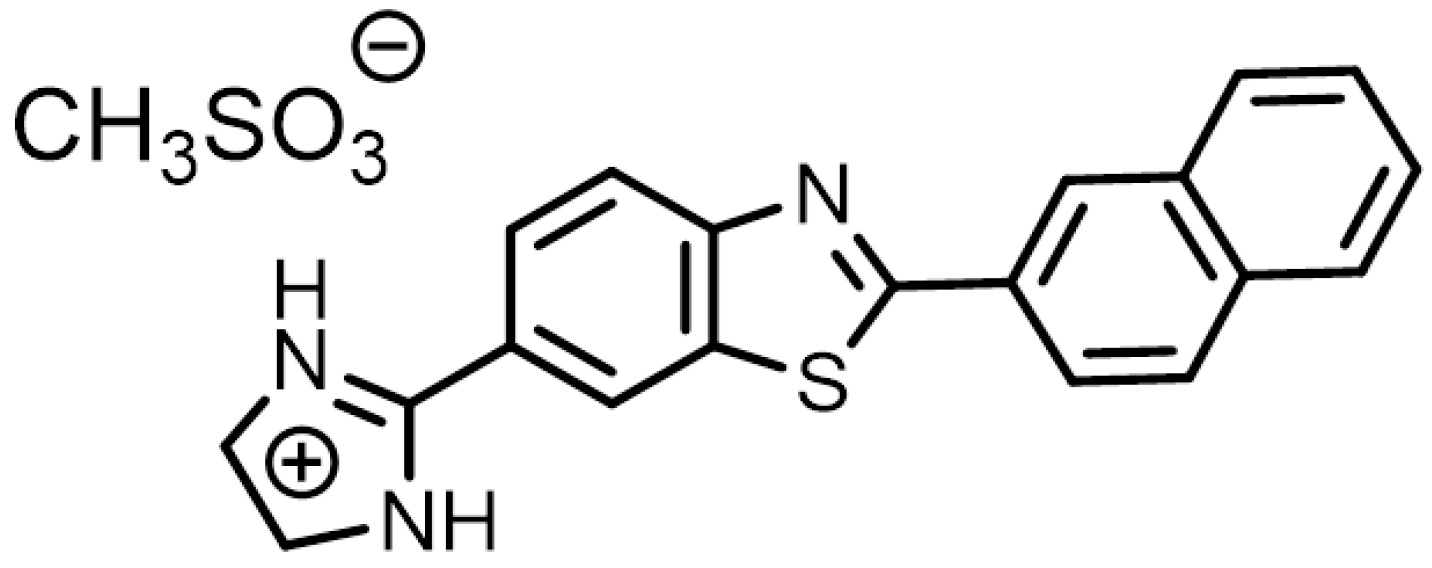
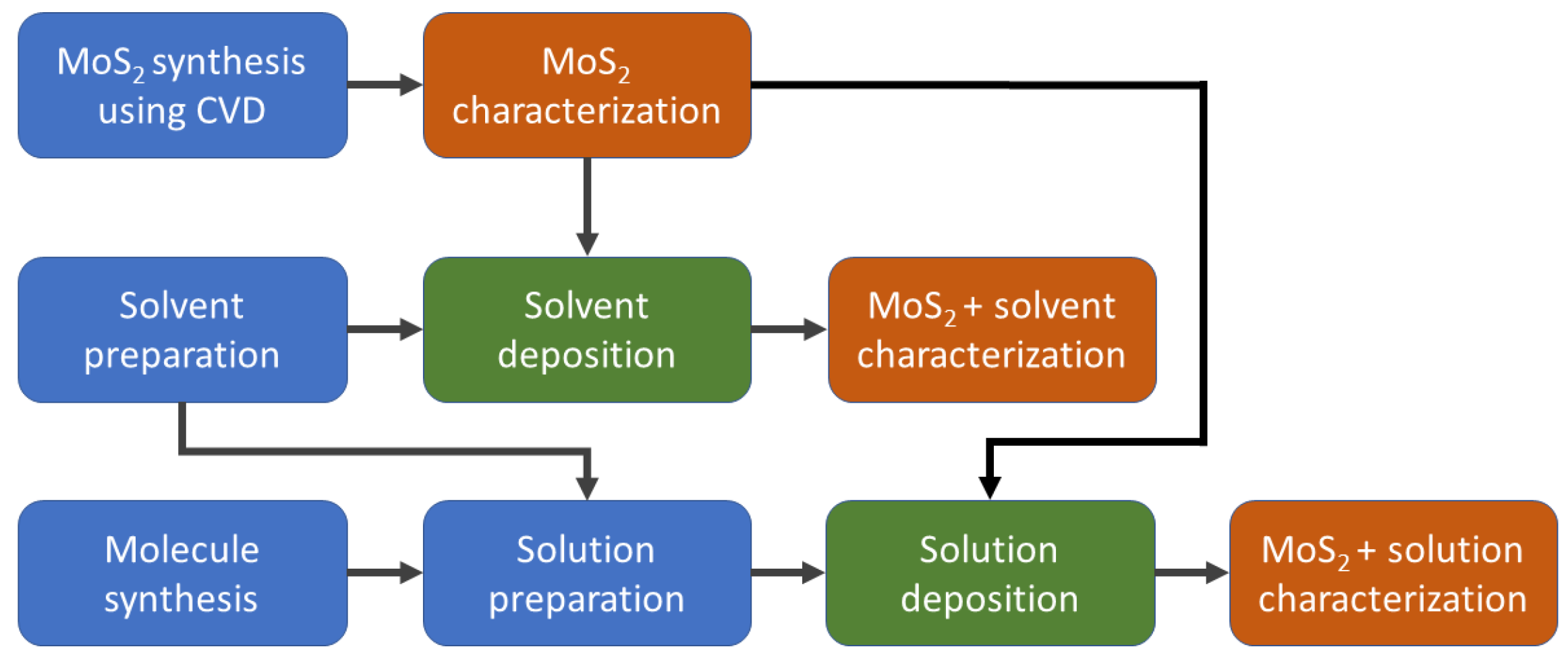
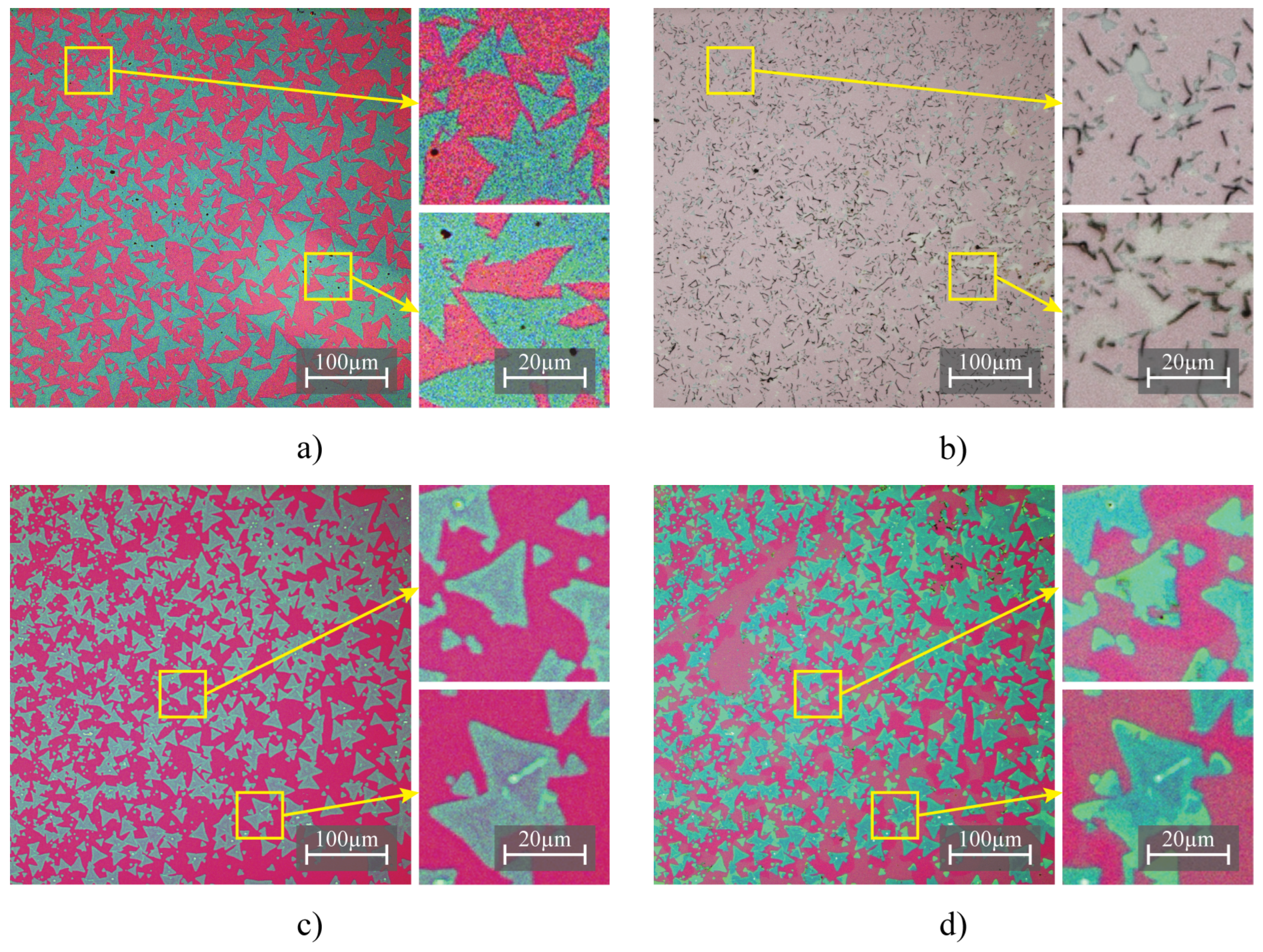
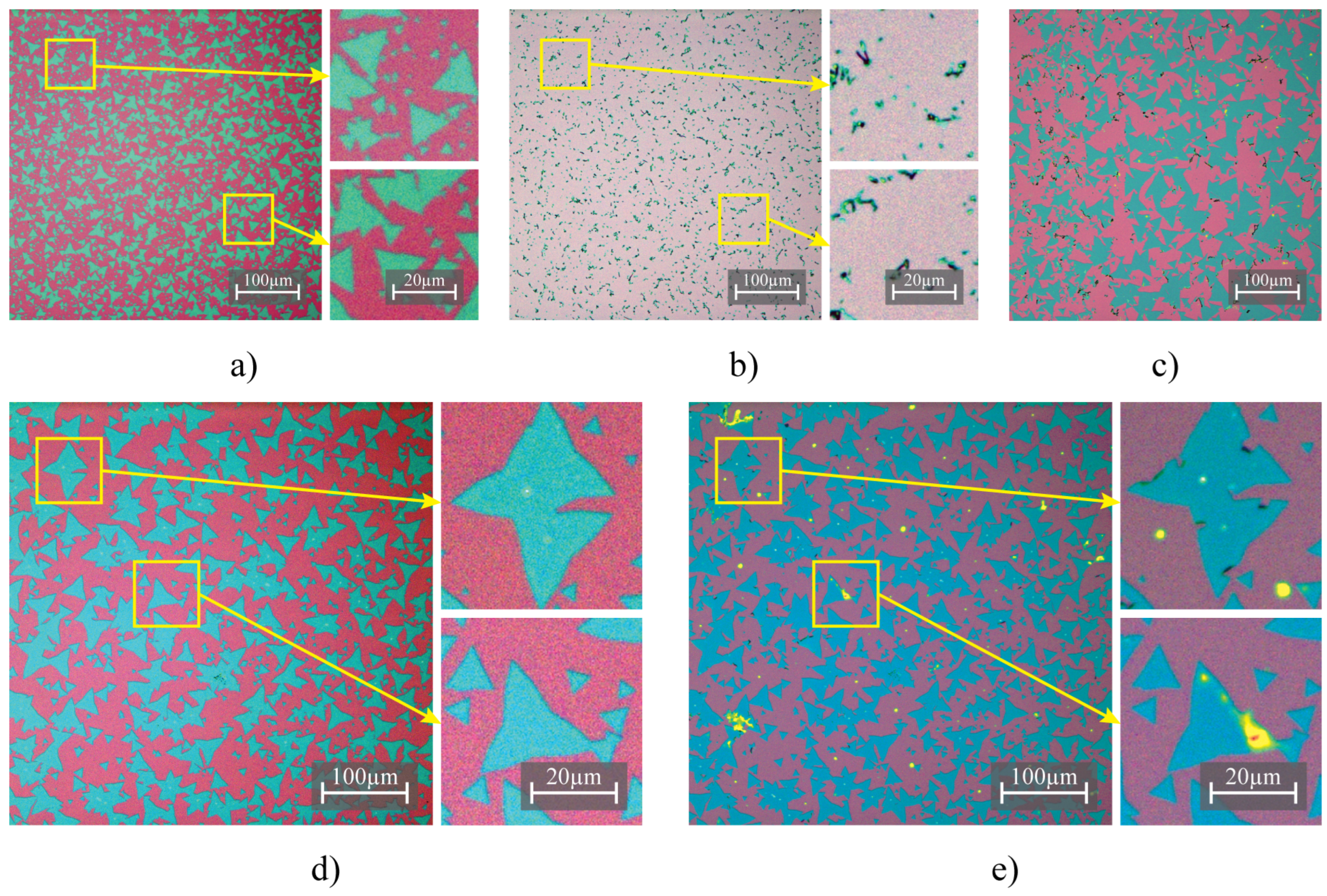
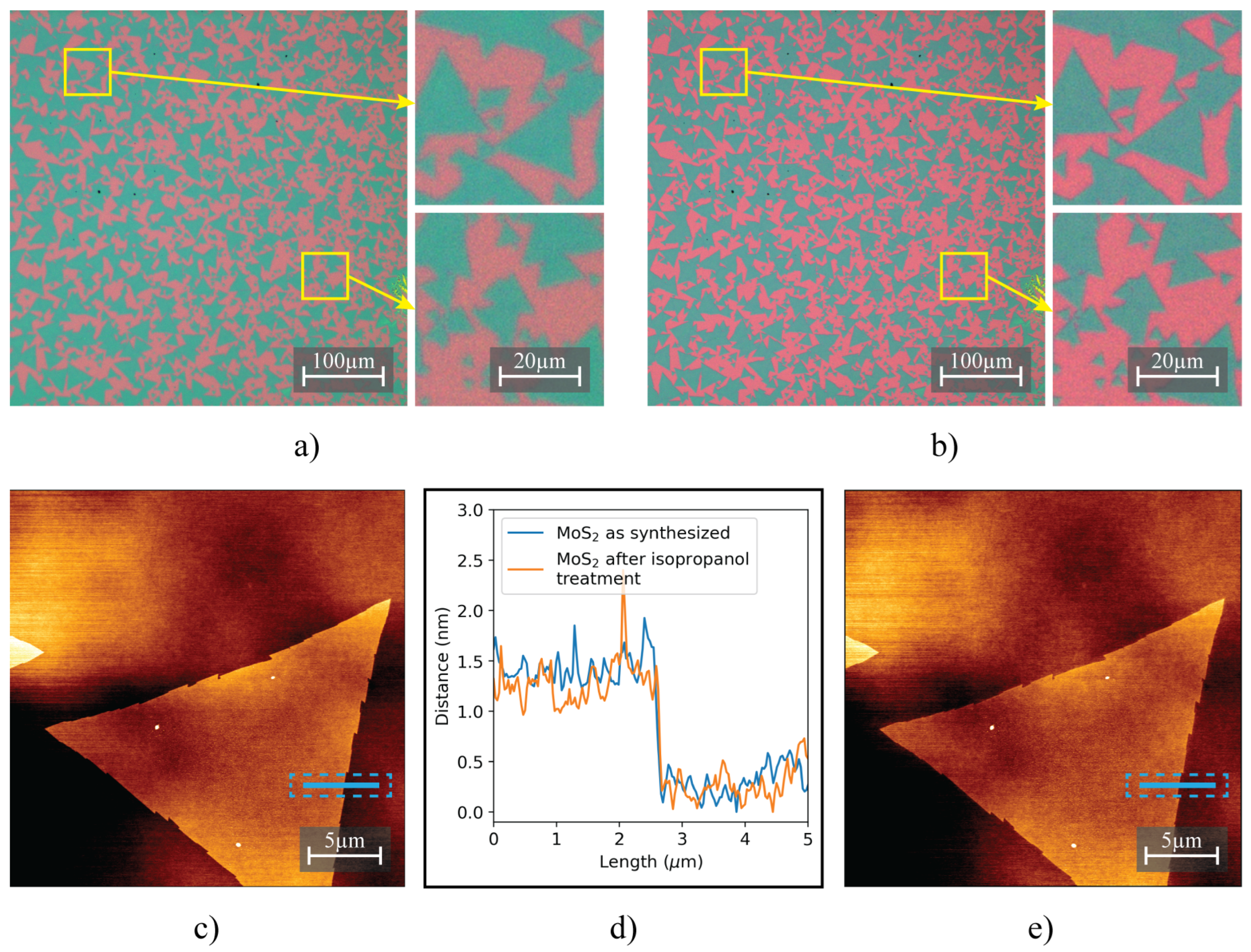
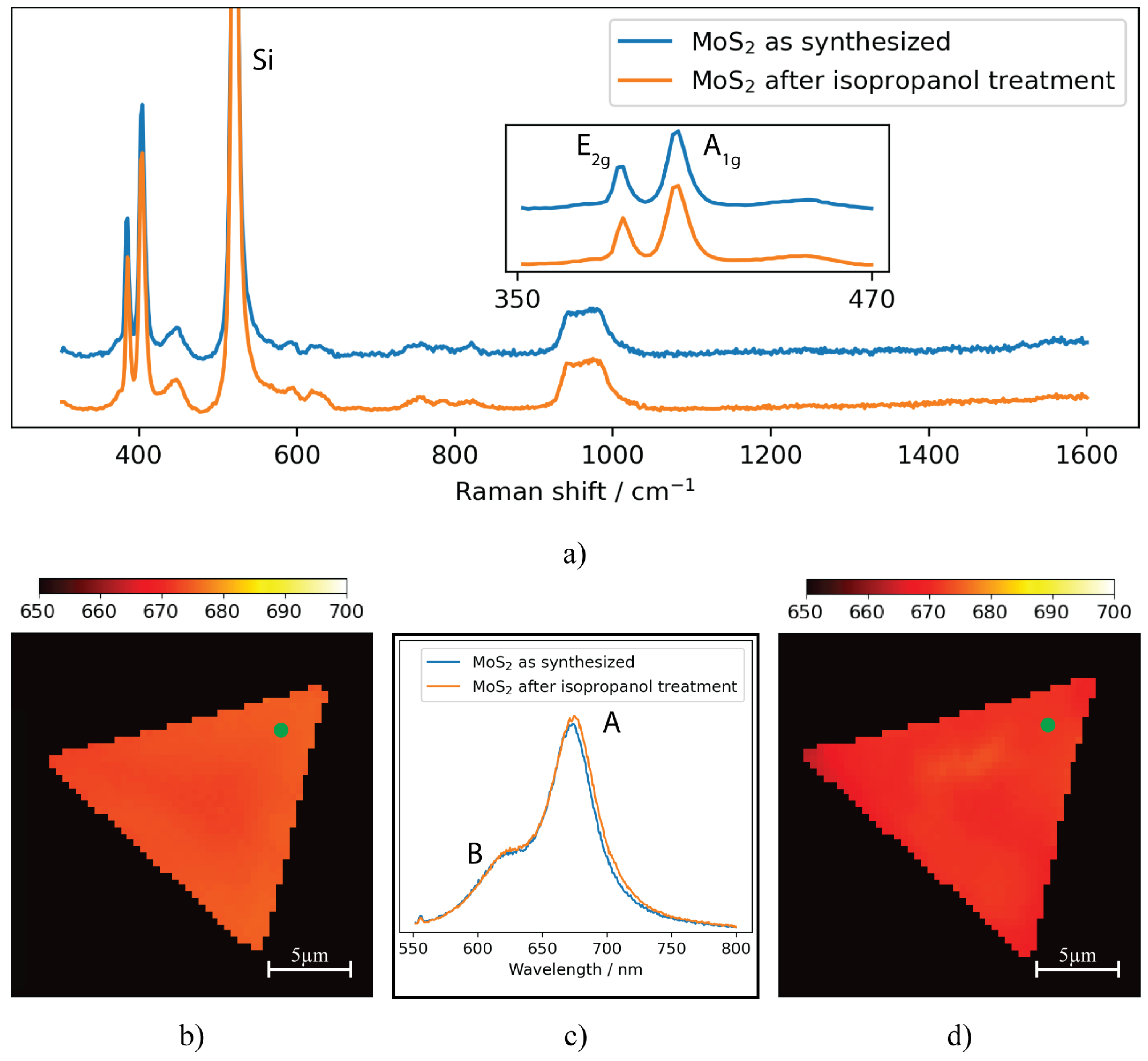
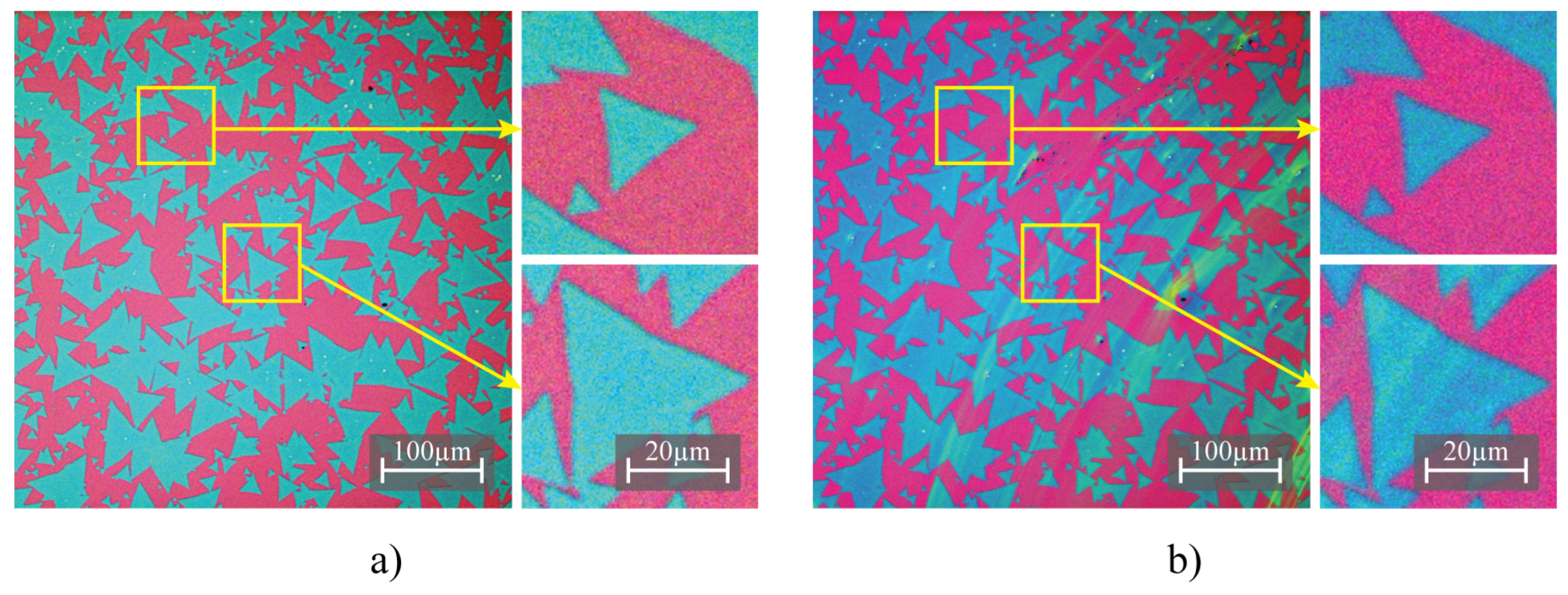

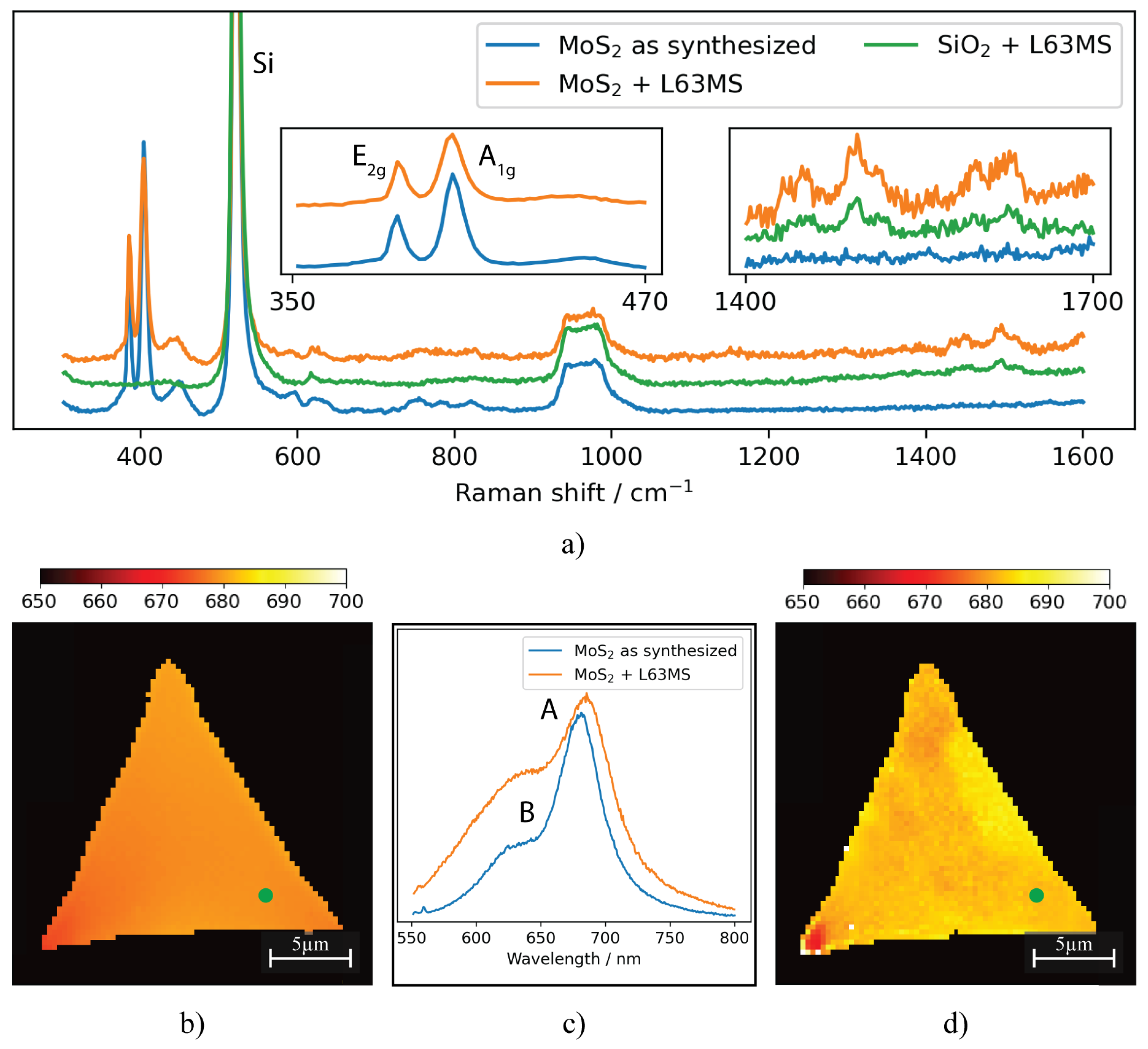
Disclaimer/Publisher’s Note: The statements, opinions and data contained in all publications are solely those of the individual author(s) and contributor(s) and not of MDPI and/or the editor(s). MDPI and/or the editor(s) disclaim responsibility for any injury to people or property resulting from any ideas, methods, instructions or products referred to in the content. |
© 2023 by the authors. Licensee MDPI, Basel, Switzerland. This article is an open access article distributed under the terms and conditions of the Creative Commons Attribution (CC BY) license (https://creativecommons.org/licenses/by/4.0/).
Share and Cite
Brkić, A.L.; Supina, A.; Čapeta, D.; Dončević, L.; Ptiček, L.; Mandić, Š.; Racané, L.; Delač, I. Influence of Solvents and Adsorption of Organic Molecules on the Properties of CVD Synthesized 2D MoS2. Nanomaterials 2023, 13, 2115. https://doi.org/10.3390/nano13142115
Brkić AL, Supina A, Čapeta D, Dončević L, Ptiček L, Mandić Š, Racané L, Delač I. Influence of Solvents and Adsorption of Organic Molecules on the Properties of CVD Synthesized 2D MoS2. Nanomaterials. 2023; 13(14):2115. https://doi.org/10.3390/nano13142115
Chicago/Turabian StyleBrkić, Antun Lovro, Antonio Supina, Davor Čapeta, Lucija Dončević, Lucija Ptiček, Šimun Mandić, Livio Racané, and Ida Delač. 2023. "Influence of Solvents and Adsorption of Organic Molecules on the Properties of CVD Synthesized 2D MoS2" Nanomaterials 13, no. 14: 2115. https://doi.org/10.3390/nano13142115
APA StyleBrkić, A. L., Supina, A., Čapeta, D., Dončević, L., Ptiček, L., Mandić, Š., Racané, L., & Delač, I. (2023). Influence of Solvents and Adsorption of Organic Molecules on the Properties of CVD Synthesized 2D MoS2. Nanomaterials, 13(14), 2115. https://doi.org/10.3390/nano13142115





